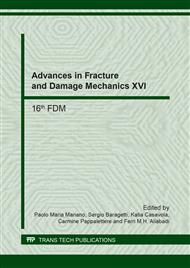p.185
p.189
p.194
p.198
p.202
p.206
p.210
p.214
p.218
On the Modelling of Creep Fracture and Fatigue
Abstract:
In this paper, a thermodynamically consistent formulation for the analysis of creep fracture and fatigue is presented. The model is described via two potential functions, the specific Helmholtz free energy and the complementary dissipation potential. Isotropic damage variable is used to describe the degradation of the material. In addition, the use of creep parameters, like Monkman-Grant and Larson-Miller parameters are discussed and their relation to the proposed model are derived. Developed model is implemented as a user subroutine to the commercial finite element code ANSYS and an example case of practical interest is shown.
Info:
Periodical:
Pages:
202-205
Citation:
Online since:
September 2017
Authors:
Price:
Сopyright:
© 2017 Trans Tech Publications Ltd. All Rights Reserved
Share:
Citation:


